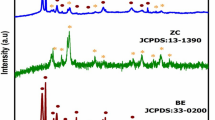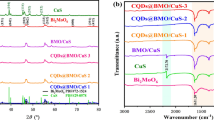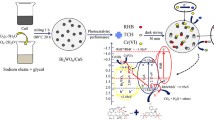Abstract
Simultaneous removal of antibiotics and heavy metals via photocatalysis in wastewater treatment field are highly desirable but still challenging. Herein, a novel 3D hierarchical Bi2MoO6/Bi2WO6 (BMW-x, x = 5, 10, 20 and 50) S-scheme heterojunction was prepared via facile two-step hydrothermal strategy. The morphology, structure, composition and photoelectrical property of the as-prepared photocatalysts were investigated using multiple advanced techniques. The optimized BMW-20 heterostructure exhibited remarkable removal efficiencies for colored dye rhodamine B, colorless antibiotic metronidazole (MNZ), and hexavalent chromium Cr (VI) with percentages reaching 96.5%, 83.5%, and 80.3% respectively within 2 h, surpassing the individual component’s performance. The removal rates of MNZ and Cr (VI) over BMW-20 in the coexisting system increased to 85.4% and 92.3%, respectively, and were higher than that of the single pollutant system, thus indicating a synergistic effect between simultaneous degradation of organic matter and reduction of heavy metal. The enhanced photocatalytic activity of BMW-20 can be attributed to its improved visible-light absorption and reduced electron–hole recombination. Free radical trapping experiments and electron spin resonance spectroscopy reveal that the photogenerated holes and hydroxyl radical play the crucial roles in the degradation of MNZ, while photoinduced electrons and superoxide anion are mainly responsible for the reduction of Cr (VI). Based on band-gap structure and active substance analysis, a detailed discussion was conducted on the possible mechanism of photocatalytic oxidation–reduction. This work provides a new insight into designing S-scheme heterojunction photocatalysts with high oxidation–reduction ability.












Similar content being viewed by others
Explore related subjects
Discover the latest articles, news and stories from top researchers in related subjects.Data availability
No data was used for the research described in the article.
References
Y.L. Dong, Q.W. Wang, J.Y. Zhu, L.L. Liang, D.Y. Xu, X.Y. Mi, Z.J. Ren, P.F. Wang, A comprehensive study on the co-removal of Cr (VI) and ciprofloxacin via microbial-photocatalytic coupling: mechanistic insights and performance evaluation. J. Environ. Manage. 352, 120044 (2024)
J. Yang, L. Li, J. Wang, H.X. Zhang, L. Wei, X.D. Yang, Synthesis of visible-light driven CdS/(I/S) composite with efficient photocatalytic activities for dyes and Cr(VI). Opt. Mater. 148, 114963 (2024)
Z.X. Yang, Z.Z. Wang, J.T. Wang, Y. Li, G.K. Zhang, Facet-dependent activation of oxalic acid over magnetic recyclable Fe3S4 for efficient pollutant removal under visible light irradiation: enhanced catalytic activity, DFT calculations, and mechanism insight. Environ. Sci. Technol. 56, 18008–18017 (2022)
C.E. Barrera-Díaz, V. Lugo-Lugo, B. Bilyeu, A review of chemical, electrochemical and biological methods for aqueous Cr(VI) reduction. J. Hazard. Mater. 223, 1–12 (2012)
S.A. Dingsdag, N. Hunter, Metronidazole: an update on metabolism, structure-cytotoxicity and resistance mechanisms. J. Antimicrob. Chemoth. 73, 265–279 (2018)
Y.H. Yan, T.J. Ni, J.G. Du, L. Li, S. Fu, K. Li, J.G. Zhou, Green synthesis of balsam pear-shaped BiVO4/BiPO4 nanocomposite for degradation of organic dye and antibiotic metronidazole. Dalton Trans. 47, 6089–6101 (2018)
K. GracePavithra, V. Jaikumar, P.S. Kumar, P. SundarRajan, A review on cleaner strategies for chromium industrial wastewater: present research and future perspective. J. Clean. Prod. 228, 580–593 (2019)
M. Bin-Jumah, M.E. Abd El-Hack, S.A. Abdelnour, Y.A. Hendy, H.A. Ghanem, S.A. Alsafy, A.F. Khafaga, A.E. Noreldin, H. Shaheen, D. Samak, M.A. Momenah, A.A. Allam, A.A. AlKahtane, S. Alkahtani, M.M. Abdel-Daim, L. Aleya, Potential use of chromium to combat thermal stress in animals: a review. Sci. Total. Environ. 707, 135996 (2020)
Z.H. Jabbar, B.H. Graimed, M.M. Alsunbuli, D.A. Sabit, Developing a magnetic bismuth-based quaternary semiconductor boosted by plasmonic action for photocatalytic detoxification of Cr(VI) and norfloxacin antibiotic under simulated solar irradiation: synergistic work and radical mechanism. J. Alloy. Compd. 958, 170521 (2023)
C. Lykos, S. Sioulas, I. Konstantinou, g-C3N4 as photocatalyst for the removal of metronidazole antibiotic from aqueous matrices under lab and pilot scale conditions. Catalysts 13, 254 (2023)
C. Wang, H.Y. Liu, G.F. Wang, H.Y. Fang, X.G. Yuan, C.M. Lu, Photocatalytic removal of metronidazole and Cr (VI) by a novel Zn3In2S6/Bi2O3 S-scheme heterojunction: performance, mechanism insight and toxicity assessment. Chem. Eng. J. 450, 138167 (2022)
J.L. Sun, Y.P. Hou, Z.B. Yu, L.L. Tu, Y.M. Yan, S.M. Qin, S. Chen, D.Q. Lan, H.X. Zhu, S.F. Wang, Visible-light-driven Z-scheme Zn3In2S6 /AgBr photocatalyst for boosting simultaneous Cr (VI) reduction and metronidazole oxidation: kinetics, degradation pathways and mechanism. J. Hazard. Mater. 419, 126543 (2021)
J.X. Low, J.G. Yu, M. Jaroniec, S. Wageh, A.A. Al-Ghamdi, Heterojunction photocatalysts. Adv. Mater. 29, 1601694 (2017)
S.J. Song, Z.P. Xing, H.A. Zhao, Z.Z. Li, W. Zhou, Recent advances in bismuth-based photocatalysts: environment and energy applications. Green Energy Environ. 8, 1232–1264 (2023)
C. Murugan, A.S. Soundarya Mary, P. Murugan, A. Pandikumar, Enhanced photoelectrocatalytic water splitting in Bi2Mo1-xWxO6 solid solutions: understanding the atomic level mechanism from the experimental and first-principles approach. ACS Appl. Energy Mater. 6, 8410–8421 (2023)
M. Arif, A. Mahsud, A. Ali, S.P. Liao, J.W. Xia, H. Xiao, M. Azam, T. Muhmood, Z.S. Lu, Y.J. Chen, Unraveling the synergy of interface engineering α-MnO2/Bi2WO6 heterostructures and defective active sites for superdurable photocatalysis: mechanistic insights into charge separation/transfer. Chem. Eng. J. 475, 146458 (2023)
W. Wang, J.M. Tian, Z.J. Zhu, C.M. Zhu, B.J. Liu, C.Y. Hu, Insight into quinolones and sulfonamides degradation, intermediate product identification and decomposition pathways with the assistance of Bi2MoO6/Bi2WO6/MWCNTs photocatalys. Process Saf. Environ. 147, 527–546 (2021)
S.B. Cao, L. Wu, J. Li, Y. Li, K. Da, W.T. Chen, R.T. Xue, J. Yang, X.M. Fan, Unraveling the generation mechanism of singlet oxygen in Bi2WxMo1-xO6 solid solution and roles in photocatalytic degradation of gaseous toluene under visible-light irradiation. J. Environ. Chem. Eng. 12, 112321 (2024)
T.T. Wang, H. Shi, A. Kumar, D. Zhang, H.X. Wang, S. Wang, J.Y. Zheng, Efficient visible-light photocatalysis of chloramphenicol using novel engineered biochar-based Ti-doped Bi2WO6 composite: mechanisms, degradation pathways, and applications. Sep. Purif. Technol. 332, 125780 (2023)
F.Y. Yan, Y. Wang, C.H. Yi, J.X. Xu, B.W. Wang, R. Ma, M. Xu, Construction of carbon dots modified Cl-doped Bi2WO6 hollow microspheres for boosting photocatalytic degradation of tetracycline under visible light irradiation. Ceram. Int. 49, 7214–7222 (2023)
R. Tai, S. Gao, Y. Tang, X.B. Ma, P.R. Ding, R.J. Wu, P.S. Li, X.J. Song, S.W. Chen, Q. Wang, Defect engineering of Bi2WO6 for enhanced photocatalytic degradation of antibiotic pollutants. Small 23, 10785 (2024)
J. Xiong, H.Y. Zeng, Z.L. Yang, J.F. Peng, B. Wu, S.G. Liu, Engineering oxygen vacancies in Bi2WO6 by introducing heteroatoms for enhancing photo-oxidation/reduction activities. Ceram. Int. 49, 35927–35938 (2023)
H.D. Luo, S. Dong, H. Li, S.H. Chen, J. Huang, K.Z. Xu, Novel dual S-scheme BiOI/AgI/Bi2WO6 heterojunction with enhanced photocatalytic activity for highly efficient removal of organic pollutants. Opt. Mater. 140, 113842 (2023)
X.T. Liu, S.N. Gu, Y.J. Zhao, G.W. Zhou, W.J. Li, BiVO4, Bi2WO6 and Bi2MoO6 photocatalysis: a brief review. J. Mater. Sci. Technol. 56, 47–70 (2020)
R.F. Chen, W. Zhou, W.W. Qu, Y.J. Wang, L.Y. Shi, S.M. Chen, A novel hierarchical nanostructured S-scheme RGO/Bi2MoO6/Bi2WO6 heterojunction: excellent photocatalytic degradation activity for pollutants. Appl. Surf. Sci. 588, 152788 (2022)
S.J. Li, M.J. Cai, Y.P. Liu, C.C. Wang, K.L. Lv, X.B. Chen, S-Scheme photocatalyst TaON/Bi2WO6 nanofibers with oxygen vacancies for efficient abatement of antibiotics and Cr(VI): intermediate eco-toxicity analysis and mechanistic insights. Chinese J. Catal. 43, 2652–2664 (2022)
S. Wang, H.P. Yang, S.Y. Feng, W. Zhang, X.D. Kang, J.P. Yue, M. Wu, L.A. Wang, Y.K. Yang, Self-regulated S-scheme heterojunction for synergistic removal of tetracycline and hexavalent chromium: synergistic mechanism of trivalent chromium. Chem. Eng. J. 472, 145058 (2023)
H.T. Ren, F. Qi, A. Labidi, J.J. Zhao, H. Wang, Y. Xin, J.M. Luo, C.Y. Wang, Chemically bonded carbon quantum dots/Bi2WO6 S-scheme heterojunction for boosted photocatalytic antibiotic degradation: interfacial engineering and mechanism insight. Appl. Catal. B-environ. 330, 122587 (2023)
B. Ashok, K. Ramesh, D. Madhu, T. Nagesh, B. Vijaya Kumar, G. Upender, Characterization and photocatalysis of visible light driven Z-scheme Bi2WO6/Bi2MoO6 heterojunction for rhodamine B degradation. Inorg. Chem. Commun. 150, 110495 (2023)
H. Salari, Facile synthesis of new Z-scheme Bi2WO6/Bi2MoO6 p-n junction photocatalysts with high photocatalytic activity: structure, kinetics and mechanism approach. Mater. Res. Bull. 131, 110979 (2020)
Q.Y. Wang, Y.H. Zhao, Z.F. Zhang, S.W. Liao, Y.D. Deng, X. Wang, Q.L. Ye, K.S. Wang, Facile synthesis of Bi2WO6/Bi2MoO6 Z-scheme heterojunction for dye degradation and Cr(VI) reduction. J. Mol. Liq. 383, 122164 (2023)
J.D. Hu, D.Y. Chen, Z. Mo, N.J. Li, Q.F. Xu, H. Li, J.H. He, H. Xu, J.W. Lu, Z-Scheme 2D/2D heterojunction of black phosphorus/monolayer Bi2WO6 nanosheets with enhanced photocatalytic activities. Angew. Chem. Int. Ed. 58, 2073–2077 (2019)
K.F. Zhang, H.X. Chen, Y.X. Liu, J.G. Deng, L. Jing, A. Rastegarpanah, W.B. Pei, Z. Han, H.X. Dai, Two-dimensional Bi2WxMo1-xO6 solid solution nanosheets for enhanced photocatalytic toluene oxidation to benzaldehyde. Appl. Catal. B Environ. 315, 121545 (2022)
F.J. Zhang, S.F. Zhu, F.Z. Xie, J. Zhang, Z. Da Meng, Plate-on-plate structured Bi2MoO6/Bi2WO6 heterojunction with high-efficiently gradient charge transfer for decolorization of MB. Sep. Purif. Technol. 113, 1–8 (2013)
G.M. Ren, S.T. Liu, X.C. Meng, Photocatalytic reduction of CO2 on a Bi2MoxW1-xO6 solid solution with enhanced activity. Inorg. Chem. 61, 9405–9412 (2022)
M. Sharma, A. Kumar, D. Gill, S. Jaiswal, A. Patra, S. Bhattacharya, V. Krishnan, Boosting Photocatalytic nitrogen fixation via nanoarchitectonics using oxygen vacancy regulation in W-doped Bi2MoO6 nanosheets. ACS Appl. Mater. Interfaces 15, 55765–55778 (2023)
H.H. Sun, C.J. Zou, W.Y. Tang, Designing double Z-scheme heterojunction of g-C3N4/Bi2MoO6/Bi2WO6 for efficient visible-light photocatalysis of organic pollutants. Colloid Surf. A 654, 130105 (2022)
C.C. Piao, L. Chen, Z.Y. Liu, J.H. Tang, Y. Liu, Y.T. Lin, D.W. Fang, J. Wang, Construction of solar light-driven dual Z-scheme Bi2MoO6/Bi2WO6/AgI/Ag photocatalyst for enhanced simultaneous degradation and conversion of nitrogenous organic pollutants. Sep. Purif. Technol. 274, 119140 (2021)
L.W. Zhang, T.G. Xu, X. Zhao, Y.F. Zhu, Controllable synthesis of Bi2MoO6 and effect of morphology and variation in local structure on photocatalytic activities. Appl. Catal. B Environ. 98, 138–146 (2010)
S. Vahabirad, A. Nezamzadeh-Ejhieh, Evaluation of the photodegradation activity of bismuth oxoiodide/bismuth sub-carbonate nanocatalyst: experimental design and the mechanism study. Ecotox. Environ. Safe. 63, 115254 (2023)
W.J. Xue, Z.W. Peng, D.L. Huang, G.M. Zeng, X.J. Wen, R. Deng, Y. Yang, X.L. Yan, In situ synthesis of visible-light-driven Z-scheme AgI/Bi2WO6 heterojunction photocatalysts with enhanced photocatalytic activity. Ceram. Int. 45, 6340–6349 (2019)
J.L. Lv, J.F. Zhang, J. Liu, Z. Li, K. Dai, C.H. Liang, Bi SPR-promoted Z-scheme Bi2MoO6/CdS-diethylenetriamine composite with effectively enhanced visible light photocatalytic hydrogen evolution activity and stability. ACS Sustainable Chem. Eng. 6, 696–706 (2018)
S.W. Hu, J. Zhu, L. Wu, X.X. Wang, P. Liu, Y.F. Zhang, Z.H. Li, Effect of fluorination on photocatalytic degradation of rhodamine B over In(OH)ySz: promotion or suppression? J. Phys. Chem. C 115, 460–467 (2011)
Z.Q. Fang, X.Q. Qiu, J.H. Chen, X.H. Qiu, Degradation of metronidazole by nanoscale zero-valent metal prepared from steel pickling waste liquor. Appl. Catal. B Environ. 100, 221–228 (2010)
Y.Y. Zhao, X.H. Liang, X.Y. Hu, J. Fan, rGO/Bi2WO6 composite as a highly efficient and stable visible-light photocatalyst for norfloxacin degradation in aqueous environment. J. Colloid Interf. Sci. 589, 336–346 (2021)
T.Y. Wang, S.X. Liu, W. Mao, Y.C. Bai, K. Chiang, K. Shah, J. Paz-Ferreiro, Novel Bi2WO6 loaded N-biochar composites with enhanced photocatalytic degradation of rhodamine B and Cr(VI). J. Hazard. Mater. 389, 121827 (2020)
X.W. Ruan, C.X. Huang, H. Cheng, Z.Q. Zhang, Y. Cui, Z.Y. Li, T.F. Xie, K.K. Ba, H.Y. Zhang, L. Zhang, X. Zhao, J. Leng, S.Y. Jin, W. Zhang, W.T. Zheng, S.K. Ravi, Z.F. Jiang, X.Q. Cui, J.G. Yu, A twin S-scheme artificial photosynthetic system with self-assembled heterojunctions yields superior photocatalytic hydrogen evolution rate. Adv. Mater. 35, 2209141 (2023)
J. Li, J.C. He, C. Si, M.X. Li, Q.X. Han, Z.L. Wang, J.W. Zhao, Special-selective C-H oxidation of toluene to benzaldehyde by a hybrid polyoxometalate photocatalyst including a rare [P6W48Fe6O180]30- anion. J. Catal. 392, 244–253 (2020)
L.Y. Zhang, J.J. Zhang, H.G. Yu, J.G. Yu, Emerging S-scheme photocatalyst. Adv. Mater. 34, 2107668 (2022)
R. He, Z.Z. Wang, F. Deng, X.B. Li, Y.Z. Peng, Y. Deng, J.P. Zou, X.B. Luo, X.G. Liu, Tunable Bi-bridge S-scheme Bi2S3/BiOBr heterojunction with oxygen vacancy and SPR effect for efficient photocatalytic reduction of Cr(VI) and industrial electroplating wastewater treatment. Sep. Purif. Technol. 331, 123176 (2023)
Acknowledgements
This research was supported by the Soft Science Research Project of Henan Province (172400410461).
Author information
Authors and Affiliations
Contributions
Linxia Liu: Conception, design, writing-original draft, final approval of manuscript. Xiaoxiao Fu: Investigation, performance tests, analysis and revision.
Corresponding authors
Ethics declarations
Competing interests
The authors declare that they have no known competing financial interests or personal relationships that could have appeared to influence the work reported in this paper.
Additional information
Publisher's Note
Springer Nature remains neutral with regard to jurisdictional claims in published maps and institutional affiliations.
Supplementary Information
Below is the link to the electronic supplementary material.
Rights and permissions
Springer Nature or its licensor (e.g. a society or other partner) holds exclusive rights to this article under a publishing agreement with the author(s) or other rightsholder(s); author self-archiving of the accepted manuscript version of this article is solely governed by the terms of such publishing agreement and applicable law.
About this article
Cite this article
Liu, L., Fu, X. S-scheme bismuth molybdate/tungstate heterojunction for efficient abatement of dyes and antibiotic and hexavalent chromium. J Mater Sci: Mater Electron 35, 1722 (2024). https://doi.org/10.1007/s10854-024-13506-3
Received:
Accepted:
Published:
DOI: https://doi.org/10.1007/s10854-024-13506-3




